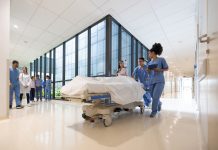A new report by the National Pharmacy Association reveals that patients spent over 6 million hours in A&E last year for minor health issues that could have been managed by community pharmacies, highlighting an opportunity to ease pressure on emergency services
The NPA reveals that patients spend over 6 million hours in Accident & Emergency (A&E) departments each year for minor, treatable conditions. This not only strains NHS resources but also leads to significant costs. The analysis highlights the urgent need to expand community pharmacy services to alleviate pressure on emergency care and improve patient outcomes.
Patients are going to A&E with blocked noses, common colds, and acne
A new analysis by the NPA of NHS England data on conditions treated in accident and emergency (A&E) departments in 2023/24 found that 325,000 people visited A&E with a sore throat or a cold, costing the NHS £44 million that year alone.
Additionally, 62,000 people visited A&E with nosebleeds, and 18,000 with blocked noses, while 40,000 attended with eczema and 1,000 with acne.
Many patients also attended A&E with conditions that can be treated through the Pharmacy First initiative. This included 18,000 patients with infected insect bites and 196,000 urinary tract infections.
Despite the fact that pharmacists are fully capable of promptly and safely managing these conditions, these visits cost the NHS a staggering £215m annually. The NPA argues that a significant amount of money could be saved if the NHS were to expand the clinical role of pharmacies.
Helping the government achieve its 4-hour wait target
Eliminating these kinds of A&E visits could help the government hit its 4-hour wait target and help those who are acutely unwell receive life-saving treatment more quickly.
The NPA isis urging the government to use the imminent publication of the NHS 10 Year Plan to ‘turbo charge’ the role of community pharmacy, freeing up time currently spent in other parts of the health system. Health Secretary Wes Streeting has previously said he wanted to use the 10 Year Plan to deliver a ‘transformational shift from hospital to the community.’
The NPA suggests that taking steps such as broadening the number of conditions covered in the Pharmacy First program could help relieve the strain on overcrowded A&E departments.
Additionally, the NPA has called for enhanced signposting from the NHS 111 service to guide more patients with minor ailments to their local Pharmacy or GP, rather than a hospital.
Pharmacists are equipped to deal with a wide range of conditions
In England, pharmacists can currently supply prescription-only and pharmacy medicines for seven common conditions without a patient having to see their GP, including infected insect bites, shingles, and uncomplicated urinary tract infections.
The NPA is calling on the government to include additional conditions, such as constipation, diarrhea, and certain bacterial skin infections, to bring it into line with the service in Scotland.
Henry Gregg, Chief Executive of the National Pharmacy Association, said: “Of course, people with serious injuries should go to A&E, but it should be a place for emergencies, not the first place to go when faced with a minor ailment. Our analysis clearly shows a substantial number of visits to A&E could be better managed in a local pharmacy. This would be more convenient for patients, who could be treated in minutes on their doorstep and save substantial time and money in one of the busiest parts of our NHS.”
“The government has a once-in-a-generation opportunity to use the 10-Year Plan to turbocharge the role of community pharmacies who, properly funded, have a vital part to play in creating a neighborhood health service. Investing in more clinical services in pharmacies will not only help alleviate the 8 AM scramble for a GP appointment but also help patients transition out of hospitals and into the community. Pharmacies still face considerable funding pressures which need resolving, and investment in them is key if the government are to shift care to people’s local communities.”
Responding to an analysis by the National Pharmacy Association, Ruth Rankine, director of the primary care network at the NHS Confederation, said: “Pharmacy continues to play an ever-increasing role in primary care, providing vital support to GPs and their teams and helping to reduce pressure on emergency and urgent care services. This new report shows that there are still large numbers of people going to A&E who could receive care more quickly from GPs and pharmacies, which is more convenient for them and more cost-effective for the NHS.
“Pharmacy First has been a very good starting point to increasing the amount of support pharmacists can offer the public. We welcome its expansion along with the roll out of independent prescribing and more coming on stream, but there is still the need to cut bureaucracy and improve digital interoperability to allow for greater integration between the different parts of the system.
“Our community pharmacy members are ambitious, innovative and want to work with partners to deliver new models of care, and better support local communities. With the upcoming ten-year plan expected to speed up the shift towards the NHS becoming a neighbourhood-based, integrated care model, Pharmacy stands ready to provide a reimagined front door to the NHS.”











